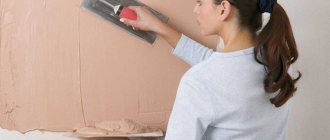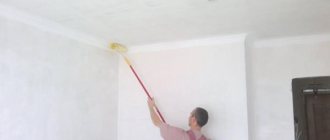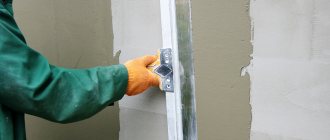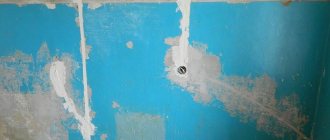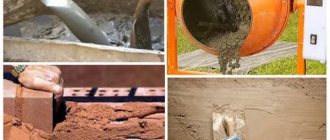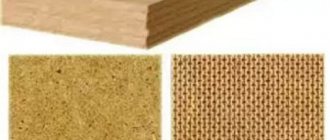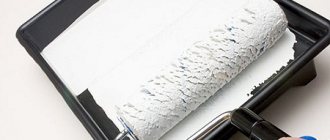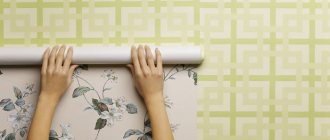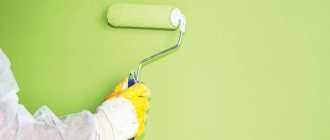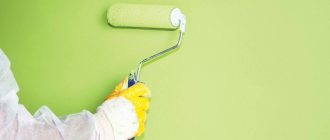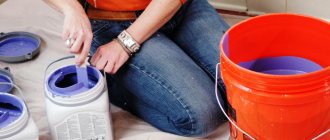When considering this method of leveling surfaces, such as plastering walls, one cannot ignore the issue of compatibility of plaster and various painting compositions. Many novice builders and people who have nothing to do with painting work face such problems. Can plaster be applied over paint? This topic is associated with a lot of controversy. That is why in this article we have tried to highlight for you universal methods of applying plaster to painted load-bearing structures.
Is it possible to apply plaster over paint?
Perhaps, by applying plaster to the paint layer, we are connecting the incompatible. And it happens that we pair two materials that get along with each other.
The possibility of a positive decision depends on several factors:
- compositions of paint and solution;
- condition of the old coating (paint film);
- the size of the thickness of the plaster layer (the weight of the coating depends).
There are circumstances in which plastering over old paint finishes is definitely not possible. Therefore, only in some cases do we answer the question “is it possible to plaster?” - Yes.
You can plaster over paint if the following conditions are met:
- compatibility of paint film and plaster compositions;
- creating an intermediate layer of material that is equally compatible with both of them;
- performing high-quality preparation of painted walls for plastering;
- The humidity in the room should not be high.
Additional compositions for processing decorative plaster
You can make the appearance of plaster more impressive and create an additional protective layer using wax, varnish and various glazes.
Wax creates a protective, waterproof coating that gives the surface a shine and bright color. Suitable for any type of plaster, looks especially impressive on Venetian. Both transparent and colored formulations are available for sale. Before application, dust must be thoroughly removed from the base. Plaster coating is done in one go without stopping. The setting time of the wax is about 4 hours; during this period, the resulting flaws can still be corrected.
Varnish is a single-layer finishing coat. Creates a durable water-repellent film on the surface that strengthens the plaster, protects it from damage and, most importantly, makes the appearance of the finish more attractive. Acrylic varnishes are used for indoor work, and organic solvents for outdoor work.
Before work, mix the composition thoroughly, add glitter or coloring pigment if necessary. The coating is done in one layer using a foam roller. Approximate consumption – 50-80 g/m².
Glaze is a glazing translucent composition for the final coating of paint, allowing for smooth color transitions. It is used for application on flat and textured surfaces both indoors and outdoors. Work can be carried out at temperatures below +10°C. The coating is applied with a sponge or a special mitten using strokes.
In what cases is plaster over old paint acceptable?
Each of the listed conditions needs a detailed explanation so that there is no desire to do without observing them. If the conditions are not met, after work, the paint layer may become insidious and the plaster coating will begin to fall off.
When painting, a film forms on the surface. The qualities and properties of the film depend on the chemical composition of the binder, as well as on the physical properties of fillers and additives.
We are considering two options from the main paint films:
- film formed as a result of dehydration of oil paint;
- film formed as a result of polymerization of a water-based composition.
oil and water-based paint
The condition of the paint film can be different: the film may already be in a state of destruction - peeling off, moving away from the base, or tenaciously clinging to it and being intact and durable. Only in the second case is it possible to plaster the painted surfaces. However, at the same time, observe the measure, limiting the load on the paint from the plaster.
Plaster mortar is a material of high self-weight. With a smooth paint film, creating a connection that can withstand high tearing forces is an impossible task, so the thickness of the plaster solution laid on top of the paint should not be exceeded, applying up to:
- 30 mm cement-sand mortars;
- 40 mm gypsum solutions.
It is important to reinforce the plaster layer if the thickness is more than 10 mm!
Is it possible to apply plaster over water-based paint?
In some cases, the water-based paint composition allows it to be used as a base for plastering. It will easily “stick” to itself compounds that have a low dead weight, and will calmly react to the proximity of clay or cement. However, he “dislikes” gypsum. Therefore, they must be connected using a primer as an intermediary.
water-based paint on the wall
Plaster over oil paint
Problematic type of coating. Surfaces painted with an oil mixture are smooth. Therefore, plaster solutions do not “stick” to them. Additional effort is required to create conditions under which the wall plaster will adhere to an oil film.
Methods for cleaning surfaces from paint
It is easier to remove water-based paint from the wall. To do this, just moisten the surface with a damp roller, foam rubber or spray and leave to “soak” for about half an hour. The softened layer of paint can be easily removed with a spatula, and the remaining material can be easily removed with sandpaper.
Do not forget! After each stage of work where the walls are moistened (with water or primer), they must be thoroughly dried.
Removing oil-based paint is a little more difficult. Here you can choose one of the methods:
- soften the paint with a special chemical solution - after application, the paint can be easily removed with a spatula. Since such products are very toxic, they cannot be used in closed or residential areas;
- soften the paint thermally. A hair dryer is perfect for this. As soon as the layer becomes pliable, it is also cleaned off with a spatula;
- clean the coating using a stiff iron brush and a grinding machine, as well as a spatula. The process will be labor-intensive and unpleasant, and most likely not all of the coating will come off.
It is precisely because of such difficulties that it is recommended to use a special primer and concrete contact for painted walls. This way you can save time and effort, and you will also be sure that you will not damage the base with brute force.
Phoenix brand concrete contact
How to plaster a painted wall
If you do decide to apply plaster over paint without removing it. It is necessary to strictly follow the technology. Let's consider sequentially what types of work must be performed so that the new coating is durable and tenaciously held on the wall.
Examination of a painted surface
What is this, what is it for? As is already known, the treatment of surfaces painted with oil compositions differs from the treatment of walls painted with water-based compositions. Therefore, first we determine what kind of base the paint film has.
To figure out what was used to paint the walls, you can use the following techniques:
- see whether the surface is glossy or matte;
- run your hand over the surface, check what trace remains on the skin;
- wet the coating;
- rub it with sandpaper.
Water-based paint looks like whitewash. Whitewash, when passed over it with your hand, leaves a whitish mark on the skin. When soaked, the whitewash darkens, the water-based emulsion remains the same color, however, when soaked, it “foams”, and if rubbed with a sponge, it will be partially erased. On sandpaper (after rubbing), the water-based film leaves smeared marks, while oil and enamel coatings leave small fragments and particles. Enamel paint compositions have a glossy surface, whitewash and water-based paints have a matte, porous surface.
checking paint adhesion to surface
Most often, oil and water-based bases are used for painting. Oil forms a dense, non-breathable film to which the plaster solution does not “stick” well. Water-based emulsion, on the contrary, with its pores allows air to pass through well, and plaster solutions adhere more firmly to it.
Preparatory work
The purpose of such work is to take measures to eliminate all defects that contribute to subsequent peeling of the plaster coating, increase adhesion, and strengthen the plaster mortar with reinforcement.
concrete contact applied to oil paint
- Check the condition of the paint film by tapping the surface of the wall. Areas where the coating moves away from the base or crumbles are cleaned with a spatula. Loose pieces of paint can be removed more easily if the painted wall is wetted.
- To increase adhesion to a wall coated with an oil or enamel paint base, notches of such depth are applied to the finish so that the underlying material is also “touched” by them.
- The surface is treated with sandpaper to get rid of the thinnest glossy smoothest layer. Sandpaper is chosen with a grain size of 60-80.
- The resulting dust is removed from the wall. Wipe the top with a cloth and dry. In a kitchen where tiny beads of grease have adhered to the finish, degreasing is required.
- The surface is coated twice with a primer. The first pass is performed with a composition that seals the pores and penetrates deeply. After drying, concrete contact is applied, which contains quartz sand grains. In this way, grip is increased. Please note that application requires a special concrete contact compound designed for application over alkyl or oil coatings (different from concrete intended for priming).
- For additional reinforcement of the plaster coating, a plaster mesh is screwed to the wall. For interior work, a mesh made of PVC or propylene is suitable; it is not screwed on, but pressed into the solution, as when reinforcing wet facades. It is important that the solution goes not only into the cells, but also between the mesh and the wall. It is better to attach the metal mesh to the ceiling with self-tapping screws.
Optimal work plan
Before you begin plastering or preparing the painted surface, you need to find out what composition it was treated with..
And here the following options are possible:
- Oil paint. It was used as an economical finishing option in old houses, as well as in public buildings. Forms an impenetrable film on the wall surface to which no leveling compound adheres. Requires very careful preparation.
- Water emulsion. Much easier from a processing point of view, since it has a more porous structure. In principle, you can plaster without preparation, but it is better to clean and prime the material.
Note! Most water-dispersed compositions have characteristics similar to water-based coatings.
In what cases should you not apply plaster to old paint?
Applying plaster to a base coated with paint was previously considered unacceptable. The use of modern means and methods of combining paint and mortar has introduced some restrictions on the conditions under which plastering is not permitted.
You definitely cannot plaster a painted surface if:
- the paint layer is destroyed or fragile (paint can be easily peeled off with a spatula and falls off the walls);
- if, in order to level the surface, it is necessary to apply a layer of plaster thicker than the dimensions indicated above;
- if the paint on the wall is water-based and the plaster solution contains gypsum;
- in rooms with high air humidity (moisture penetrating through the pores of the plaster will cause it to peel off);
- plaster the oil film directly (a primer is required to increase adhesion).
poor adhesion of paint to the surface of the base
In such cases, they either take measures to change the initial conditions (for example, replace gypsum compositions with cement, clay or acrylic), or completely remove the paint film. You can level the wall, for example, with dry plaster - plasterboard.
Paint coating analysis
The first thing you need to start with when plastering paint-coated surfaces is a thorough study of the composition of the coating. Today, there are two main types of materials that are most often used for painting walls:
- Water-based paints. Due to its unique, porous structure, water-based paint is easy to use, durable and has high adhesion to various materials. This painted surface can be leveled without any preparatory work. However, it is worth remembering that water-based paint is not compatible with gypsum mixture (for example, Rotband products can be cited).
- Oil paints. Just a few years ago, oil-based paint mixtures were used only for decorative finishing of walls in industrial, construction sites and old-style residential buildings. When using oil paint, a dense and smooth film is formed, which does not allow plastering - the plaster mixture simply will not adhere to such a surface.
How to remove old paint from walls under plaster
Removing paint is a troublesome task. The paint can stick to the base firmly in some places, but in others it easily crumbles when using a spatula. Depending on the condition of the paint coating and the capabilities of the finishers, different methods of cleaning the surface are used. Similar methods are used when removing decorative plaster.
Removal is performed:
- mechanically;
- thermally;
- chemically.
Mechanical method
Classic scraping (manual or mechanized) or grinding (abrasive removal). Performed manually or with electric or pneumatic tools. Usually the removal starts with it.
Simple, inexpensive tools include spatulas and scrapers. These tools have thin, wide blades that slide under the paint layer. The tool itself is held at a slight angle to the surface being cleaned, so when pressed, its action resembles that of a wedge that converts longitudinal force into transverse force. Paint that adheres weakly peels off easily.
removing paint with a spatula
To make the “swing” wider, a scraper or spatula is attached to an elongated handle. The telescopic handle allows you to work with this tool from the floor, even when cleaning the ceiling. You can make a scraper yourself or purchase one. Replacement blades are produced for scrapers. For our work, it is not necessary to buy the most durable thin blades. Enough cheap Chinese ones. Working with a spatula or scraper is quiet and does not disturb neighbors.
If the bond between the paint and the base is strong, its layer is separated using carpentry tools - a chisel and a hammer. Here, instead of manually pressing “to the wedge,” a striking force is applied, since the end of the chisel handle can be lightly tapped with a hammer. The disadvantage is the small size of the peel-off coating. Therefore, it would be rational to first clean (where possible) the wall with a spatula.
removing the coating with a chisel and hammer
The old paint layer can also be removed using a drill, for example, using a long bolt with a piece of chain attached. In this case, the layer is knocked down by chaotic impacts of the chain links. But along with the paint, the underlying plaster often peels off. The method is dustier and noisier. In terms of cleaning speed/operation safety ratio, it is optimal.
Preparing painted walls for plastering
Regardless of the type of old paint that once covered the wall, you must:
Thin film plaster in 11 color shades with synthetic binder resins contains natural stone. Suitable for external and internal areas with high voltage, such as stairs, corridors, stairs and various halls, respectively. plinths and columns. Fences can be applied over horizontal insulation.
Tape strips imitate cutting masonry, as was and is used in the classic design
Features: Abrasive, waterproof, alkali-resistant, impact-resistant and scratch-resistant. Eco-friendly and odorless. The use around the entrance is not just aesthetically pleasing. In this case, tiled strips protect the occupied part of the façade from damage. They can create original, very impressive interiors.
- check the strength of the surface: to determine voids and poorly adhering parts, tap the wall, scrape off weakly adhering pieces with a spatula;
- final cleaning is carried out after moistening: soaked small particles will be removed more easily.
The plaster will adhere very poorly to a smooth surface painted with oil paint or enamel. To increase adhesion, notches are applied on the painted wall at a distance of 10-12 cm from each other, slightly deeper than the thickness of the paint layer. This is done with an axe, hammer drill or chisel. For 1 sq. m there should be about 100 notches.
It can be used, for example, in restaurants or wine bars. The natural optics of cut masonry make every home original. They can only be used on solid masonry and on thermal insulation systems. The wide range of shades offers many possibilities and combinations of how to make facades according to the individual ideas of each investor.
Facade paint based on acrylic dispersion, reinforced with siloxane
As a high-quality facade coating, it is characterized by optimal protection against moisture, high water permeability for mineral plasters, dispersion plasters and synthetic resin plasters with high air permeability to water vapor. It can also be used as a restoration paint on porous concrete supports.
Then the painted wall is carefully treated with sandpaper with a coarse abrasive No. 60 or 80
. It is advisable to almost completely remove the top, thinnest and smoothest (glossy) layer.
After treatment, the wall is thoroughly dusted, wiped with a cloth and dried. If the work is carried out in the kitchen, then the surface is additionally degreased using solvents. After all, even the thinnest layer of fat can significantly reduce the adhesion of the plaster to the base.
The color of the facade is silicate, reinforced with siloxane
For high-quality coatings with high weather resistance. As a high-quality façade covering, it provides optimal moisture protection and high water vapor permeability. Matte hydrophobic, highly diffused, excellent cover.
Matte facade paint with silicone binder
It has good resistance to rainwater and high vapor permeability, and is suitable for painting mineral facade plasters, as well as for new coatings. Due to its specific properties it is also suitable for monumental and protected objects and lime plasters.
The last stage is treatment at least 2 times with a primer.
The first time with a deep penetration primer so that it penetrates into the notches, and the second time with a “concrete contact” type composition. Essentially, it is an adhesive mixture with the addition of quartz grains, which, after drying, forms a rough surface and significantly increases the adhesion (adhesion) of the plaster to the painted wall. When processing, it is necessary to ensure that the solution penetrates into the notches. Be sure to check that the concrete contact is intended specifically for treating oil and alkyd walls that cannot be removed, and not for treating concrete. A good alternative to expensive primer is tile adhesive for “particularly difficult surfaces.”
Good vapor permeability, hydrophobicity, good coverage, excellent resistance to aggressive components of polluted air, serum-free, quick-drying, easy to process, water-soluble. First, it's good to know what a primer is. This is part of the preparation of the wall before painting, when the artist dries the roller or brush with the so-called. and place the substance on the wall. This is an excellent solution if you want to protect the wall from excessive paint absorption and strengthen the color adhesion to the surface.
The effect will be uniform and, above all, you will definitely use less paint. Because of the types of pavement, we distinguish three types of ground. They can be used for primer, mineral plaster, drywall, plasterboard and easy-to-dissolve paints. – they are also acrylic earths, except that they are enriched with additional ingredients. It is used for thin surfaces, such as old glue scrapers or very soft plasters that are easy to crush. - this is a separate category of land, the task of which is to simultaneously combine color and prime the wall.
- So called. acrylic, belong to the most universal earth.
- It's just a stain.
- Thanks to the primer, we get a completely uniform coating.
Answering the question of whether it is necessary to prime the walls before painting, the answer is definitely yes.
When the thickness of the plaster layer is over 10 mm, the walls are additionally reinforced
– covered with a plaster mesh, which is screwed to the wall. Since it takes on part of the load, the likelihood that the plaster will begin to peel off is significantly reduced. In addition, such a mesh protects the surface from cracking during the drying process.
This way we reduce the absorption of the wall, so we use less paint. On the other hand, a good primer or primer paint is an added boost, so you'll end up with a color you'll enjoy for years to come. Thinning the paint does not guarantee that the color will be prettier or more durable. First of all, you have to remember that the products usually come from different companies. In practice, this means that the chemicals it contains can react with each other.
As a result, you will get a different effect than expected, and at best nothing will happen. What to do to get a beautiful wall color? Protect them properly only with priming. The output itself is very low compared to the overall cost of the painting. In return, you can be sure that the walls will be secured, strengthened, and the beautiful color will last longer. The main argument that prevails over primer is paint preservation. After surgery, the walls are much less absorbent, so we use less paint.
For interior work, you don’t need to use a metal mesh - just purchase a product made of PVC or propylene. It is simply pressed into the still uncured solution, which is then leveled with a wide spatula. Additional fasteners are not needed - the thrown plaster will create a fairly durable layer. Only a metal mesh is attached to self-tapping screws if heavy concrete mortar is used.
Just remember not to mix soil with paint: there's no benefit to it, and it could end up being another, unnecessary expense. Buildings Enclosed buildings are divided into different spaces or rooms so that they can carry out different activities for their intended purpose, such as housing, manufacturing, education, healthcare, recreation or entertainment. The buildings are equipped with the necessary means for work and comfort: water, sewerage, electricity, heating, air conditioning, vertical transport. b) Miscellaneous structures Whether buildings are closed or not: roads, railways, bridges, tunnels, dams, canals, reservoirs and tanks, viaducts, stadiums, patiniars, gas stations, industrial buildings.
The wall prepared in this way can already be plastered and you can be sure that the finish will adhere to the old paint.
Conclusion
When answering whether it is possible to apply plaster over paint, finishing craftsmen can express opposing opinions, since everyone has their own experience of working with such walls. In some cases, you can apply the solution by following the recommendations given in the article. In other cases, it is better to avoid the risk, remove the paint film and reliably plaster the painted ceiling and walls. If you are doing it for yourself and you don’t mind spending a little more time, we recommend that you clean the wall completely before plastering.
We have considered a rather controversial question, which is difficult to answer without examining the condition and quality of the paint coating in the room being repaired. Before applying plaster, the walls must be carefully prepared. Then repairs will not be needed for a long time.
How to lay tiles without removing paint
Finally, we invite you to watch the video, which shows how to prepare painted walls for laying tiles.
We hope you found this article helpful. Please ask your comments and questions in the comments below.
During the renovation of various buildings, before plastering walls and ceilings, they must be carefully prepared for this type of work.
This preparation depends on the level of the previous cladding and the top layer of coating. In this regard, the question often arises: is it possible to plaster walls and ceilings using paint?
To answer this, you need to find out several important points regarding the painted surface.
Plastering a painted building base
Before starting finishing, it is recommended that you familiarize yourself with the rules that will tell you how to apply plaster to paint so that the material adheres securely to the surface.
Surface preparation:
- Surface research. The building base is assessed for the degree of differences and curvatures to determine the thickness of the plaster layer. They study the type of coating and the reliability of fixation on the building base. Such measures will help to understand whether it is possible to apply plaster to the paint or whether the coating will have to be dismantled.
- Dismantling unreliable areas of the coating. If the paint holds firmly and only peels off in places, these areas are cleaned with a spatula or sandpaper (as in the photo below).
- Surface cleaning. Removes dirty stains and dust. In case of heavy contamination, the coating is washed with water.
- Priming the base. For this finishing stage, a penetrating paint primer is used. The surface is treated with the product twice with a break for drying. After applying the product, a rough coating is formed on the building base, which improves the adhesion of paint and plaster.
Cleaning the wall with a spatula
Latex compounds
The main point of working with this type of dye is to dry the material, which gradually transforms into a thin but durable film layer. Thanks to this property, you can carry out wet cleaning in the house, as well as outside, because all compositions made on this basis are not afraid of direct contact with liquid.
The composition of this paint has both a glossy and matte surface, which is well suited for painting plastered walls. If the wall has decorative plaster, then the latex composition is most suitable for it, this is all because no other material can highlight the volume and texture of a putty pattern of this type.
